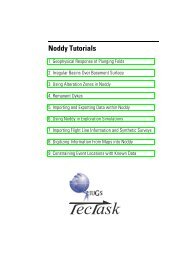Revised Eburnean geodynamic evolution of the ... - Tectonique.net
Revised Eburnean geodynamic evolution of the ... - Tectonique.net
Revised Eburnean geodynamic evolution of the ... - Tectonique.net
You also want an ePaper? Increase the reach of your titles
YUMPU automatically turns print PDFs into web optimized ePapers that Google loves.
22 S. Perrouty et al. / Precambrian Research 204– 205 (2012) 12– 39<br />
Fig. 4. Image <strong>of</strong> <strong>the</strong> gamma-ray data draped over a shaded digital elevation model. This image shows <strong>the</strong> relative proportion <strong>of</strong> potassium, thorium and uranium as an RGB<br />
image, and <strong>the</strong>ir correlation with <strong>the</strong> topography. Pixel size is 100 m. U and Th rich areas with high topography correspond to Sefwi Group metavolcanics as around Cape<br />
Three Points and proximal to <strong>the</strong> Ashanti Fault. K-rich granitoids are well defined in <strong>the</strong> eastern part <strong>of</strong> <strong>the</strong> area.<br />
gravity data can only be used to broadly differentiate regional<br />
rock packages and image <strong>the</strong> continuity <strong>of</strong> <strong>the</strong> major structures at<br />
depth.<br />
3.2.4. ALOS PALSAR data<br />
Advanced Land Observing Satellite; Phased Array type L-band<br />
Syn<strong>the</strong>tic Aperture Radar high-resolution data (ALOS PALSAR data)<br />
collected in 2009 were used to image structure within lithological<br />
packages. Two polarisation channels (HH and HV) (available from<br />
http://www.eorc.jaxa.jp/ALOS/en/) were gridded with a resolution<br />
<strong>of</strong> 50 m. A ternary RGB image was <strong>the</strong>n produced (Fig. 6), where<br />
red, green, blue colours correspond respectively to <strong>the</strong> HH, HV and<br />
(HH + HV/2) polarisations. These radar data are able to image structural<br />
details within sedimentary units such as bedding, with better<br />
resolution than <strong>the</strong> combined radiometric and digital elevation<br />
model.<br />
3.3. Petrophysics<br />
Petrophysical data were collected during regional reconnaissance,<br />
resulting in a database <strong>of</strong> over 300 susceptibility<br />
measurements <strong>of</strong> <strong>the</strong> major lithologies encountered in <strong>the</strong> Ashanti<br />
region. The data provided quantitative information on <strong>the</strong> mag<strong>net</strong>ic<br />
susceptibility <strong>of</strong> <strong>the</strong> Birimian and Tarkwaian units and intrusives<br />
that were used to constrain <strong>the</strong> regional mag<strong>net</strong>ic interpretation<br />
and subsequent geophysical modelling. These susceptibility data<br />
are consistent with common susceptibility range proposed by Clark<br />
(1997) and with values measured by Metelka et al. (2011) in Burkina<br />
Faso.<br />
The histograms in Fig. 7 show <strong>the</strong> range <strong>of</strong> measured mag<strong>net</strong>ic<br />
susceptibilities for <strong>the</strong> lithologies seen in <strong>the</strong> study area using<br />
a Ge<strong>of</strong>yzika KT-5 Kappameter hand held susceptibility meter. To<br />
ensure high quality measurements, some representative samples<br />
were re-measured using a Kappabridge KLY-3 mag<strong>net</strong>ic susceptibility<br />
meter and no statistically significant differences were<br />
found. Natural remanent mag<strong>net</strong>isation (NRM) <strong>of</strong> <strong>the</strong> dolerite<br />
dykes was measured using AGICO JR5A spinner mag<strong>net</strong>ometer,<br />
mounted within Helmholtz coil systems. Paleomag<strong>net</strong>ic laboratory<br />
experiments were carried out at <strong>the</strong> GET Mag<strong>net</strong>ism Laboratory<br />
(Toulouse).<br />
Density data were acquired for 26 samples taken from all <strong>of</strong> <strong>the</strong><br />
outcropping regional units. Calculated values derived from sample<br />
weighing in air and water (Table 5) agree with measurements<br />
made by Hasting (1978, unpublished report referenced in Barritt<br />
and Kuma (1998) and with equivalent samples from Burkina Faso<br />
(Baratoux et al., 2011).




